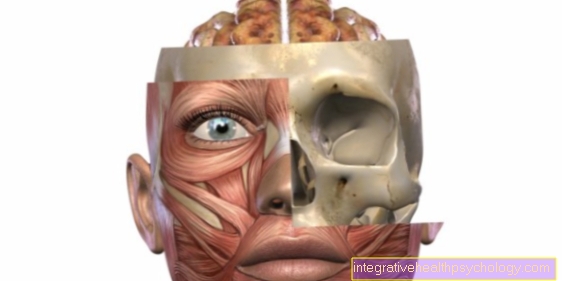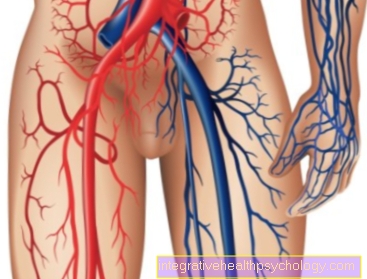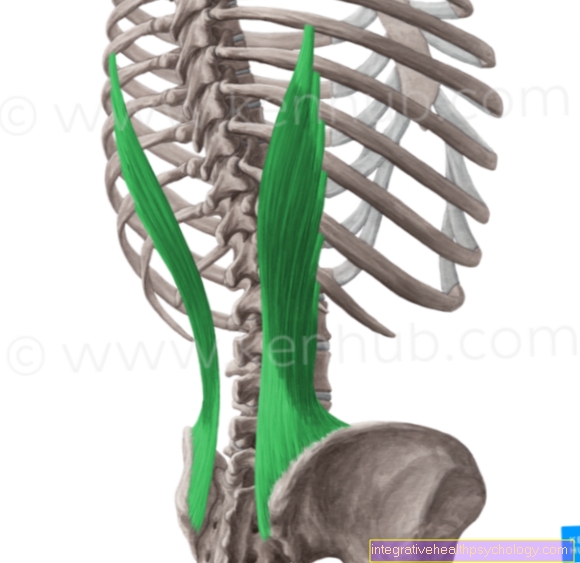Thyroid cancer
Synonyms in the broadest sense
Thyroid Cancer, Malignant Thyroid Tumors, Papillary Thyroid Carcinoma, Follicular Thyroid Carcinoma, Anablastic Thyroid Carcinoma, Medullary Thyroid Carcinoma
definition
Malignant tumors of the thyroid gland are thyroid carcinomas in 95% of cases, which can occur in different forms. Carcinomas are tumors that originate from epithelial cells of the thyroid gland.
Tumors originating from other types of cells, as well as metastases in the thyroid gland spread from other primary tumors (= original tumor), are very rare (approx. 5%).
A distinction is made between four different forms of carcinoma, which can be differentiated from one another using the following criteria:
One assesses the cell structure of the tumor, the tendency towards the formation of tumor settlements (= metastases) in the tissue and the prognosis with which the tumor shape is connected.

Epidemiology / Occurrence
Thyroid cancer is rare: 3 out of every 100,000 people in Europe develop a malignant thyroid tumor every year.
Thyroid cancer is relatively rare in Europe, with a higher incidence rate in China, Hawaii and the Chernobyl area.
The malignant tumors of the thyroid gland are the eleventh most common cause of death from cancer.
Cause / origin
An important factor for the development of malignant thyroid tumors is the effect of ionizing radiation (e.g. X-rays) on the person affected. In addition, genetic components are predisposing factors for the development of malignancies.
The damage to the genetic material in the thyroid cells leads to unhindered autonomous growth that is no longer subject to the control of hormone control systems.
Symptoms

Typical clinical signs of thyroid cancer are painless, rough lumps in the thyroid (read also nodes in the thyroid gland) and an enlargement of the entire organ (=Goiter).
Due to the enlarged thyroid gland, neighboring structures are compressed, causing it to Difficulty swallowing can come, hoarseness occurs because the
The nerve that controls the vocal folds takes its course near the thyroid gland or there is an upper congestion. If there is a congestion at the top, the venous blood can only flow back to the heart to a limited extent through the compressed neck vessels; the compression of the vessels is due to the enlarged thyroid.
Sore throat as well as retraction of the skin over the thyroid gland are possible signs of a malignant process in the thyroid gland.
Signs of thyroid cancer
The signs of thyroid cancer are varied and by no means specific to this type of cancer.
In many cases it will be a noticeable one Swelling of the cervical lymph nodes described in the area of the thyroid gland. However, this can also be a harmless one cold or a flu-like infection.
Furthermore, in numerous thyroid cancer patients a Increase in size of the thyroid gland observed, which is also referred to as goiter or goiter formation. The symptom "GoiterHowever, “is not a clear indication of the presence of cancer.
Even with one Hyperthyroidism (Hyperthyroidism) or Hypothyroidism (Hypothyroidism) as well as benign cyst formation, abnormal growth of the organ can also occur.
The first signs of thyroid cancer appear quite late, however, in the form of functional restrictions in the neighboring organs after a strong increase in the volume of the thyroid gland or as a lump that can be felt through the skin. This is only the case when the cancer has a certain diameter of at least 1.5-2cm and is therefore palpable, but not yet visible and still without symptoms.
When the cancer has reached a certain size, it is possible that it affects the windpipe (Trachea) or on the esophagus (Esophagus) pushes, thus obstructing the passage of air or food.
The patients then usually complain of shortness of breath and difficulty swallowing. The cancer can also impair the function of the larynx nerves, which are responsible for the activity of the vocal cords. Depending on the degree of restriction, unilateral or bilateral occur Vocal cord paralysis on, the signs like hoarseness, to cough or even shortness of breath (for vocal folds paralyzed on both sides) can cause.
If the central nerve tracts of the sympathetic nervous system are impaired, even the so-called Horner triad occur. There are three typical signs in the eye area:
- constricted pupils (Miosis)
- drooping upper eyelids (Ptosis) such as
- sunken eyeballs (Enophthalmos).
Typical signs for the four different types of thyroid cancer
The most common types of thyroid cancers papillary or follicular are primarily expressed by clearly swollen neck lymph nodes, as in most cases they spread over the lymphatic system and begin to spread in the local lymph nodes on the neck.
Of the medullary thyroid cancer (also Called C-cell cancer because it originates from the C-cells of the thyroid) causes hypocalcaemia due to an increased calcitonin level (low levels of calcium in the blood). The C cells of the thyroid are responsible for the production of calcitonin, which regulates calcium and phosphate levels in the body.
If these cells become degenerate, more calcitonin is produced. The signs of hypocalcemia that appear are Muscle spasms as well as sensory disturbances in the tips of the fingers and toes in the form of tingling.
Diarrhea has also been reported by some patients.
Of the anaplastic thyroid cancer on the other hand, shows a more aggressive growth behavior, which leads to the appearance of symptoms such as asymmetrical swelling on the neck, skin redness, hoarseness and difficulties swallowing leads.
All in all, most diagnoses are incidental findings that were discovered during a preventive ultrasound at the dermatologist. Since thyroid cancer shows no specific signs and all the symptoms that occur are noticeable very late, it is advisable to have a routine ultrasound of the throat and thyroid gland performed regularly.
Types of carcinoma of the thyroid gland
There are four types of malignant thyroid tumors:
- papillary thyroid carcinoma
This type of carcinoma occurs in 55% of the disease cases and is therefore the most common thyroid cancer. It is one of the differentiated carcinomas in which the cancer cells are still very similar to the healthy thyroid cells.
In the microscopic examination of the punctate cells, they arrange themselves in a certain formation, the so-called papillary shape. Although the lump and any metastases (= tumor settlements) that may already be present appear as a cold lump in the scintigram, it saves iodine, albeit less than normal thyroid tissue.
If the carcinoma forms distant settlements, it usually affects the regional lymph nodes in the lymphatic drainage area of the thyroid gland.
The prognosis for this type of tumor is relatively good, because after an operation you still have the option of radioiodine therapy (p. Thyroid cancer therapy). However, younger patients have a better prognosis than older ones.
- follicular thyroid carcinoma
Follicular thyroid carcinoma is also a differentiated thyroid tumor in which the structure of the thyroid cells is also preserved in the degenerated cells. This fact often makes diagnosis difficult, as the cancer cells are still very reminiscent of healthy thyroid cells.
Approx. 30% of all thyroid cancers are of this type.
As with papillary carcinoma, this type of tumor stores iodine, but to a lesser extent than the surrounding healthy tissue, which is why it is known as a cold lump.
The remote settlements of this tumor are caused by spreading through the bloodstream; typically the metastases are in the lung, the skeleton and the brain.
The prognosis of follicular thyroid carcinoma is good, especially in younger patients, since there are two good therapeutic options for treating the thyroid tumor (= primary tumor) and the metastases with surgery and radioiodine therapy.
- anaplastic thyroid carcinoma
This type of carcinoma shows in the histological picture, i.e. when examining the tissue samples under the microscope, undifferentiated cells that no longer resemble thyroid cells and also no longer store iodine.
Radioiodine therapy is therefore of no importance for the treatment of this form of carcinoma, since the thyroid gland does not absorb the applied radioactive iodine.
It is a very aggressive and rapidly growing tumor.
The formation of remote tumor settlements takes place via both the lymph and the blood.
Approx. 10% of all thyroid cancers are of this type.
You might also be interested in: Metastases in thyroid cancer
Note: Anaplastic thyroid carcinoma
The mean survival time of this tumor is only 8 months, which means that anaplastic carcinoma has the worst prognosis of thyroid carcinomas.
- medullary thyroid carcinoma
This form, which occurs in 5% of all thyroid carcinomas, is also called C cell carcinoma designated.
The tumor originates from the calcitonin-producing cells of the thyroid gland and not, like all other types of carcinoma listed, from the thyroid hormone-producing cells. So it does not store iodine.
Calcitonin causes i.a. the incorporation of phosphate and calcium into the bones.
Metastases spread from the primary tumor via the lymphatic and blood routes.
The prognosis for C-cell carcinoma is relatively good.
In the vast majority of cases, this carcinoma occurs sporadically and has an age peak of 50-60 years. In 20%, however, inheritance can be found in the family of the sick person. A part of these familial tumor forms occurs in the context of the MEN on; in this disease other carcinomas are located in endocrine, i. e. hormone-producing organs, before like the pancreas or the Adrenal gland. A distinction is made between three forms of MEN, which, depending on the type, occur between the ages of 10 and 50.
forecast
The prognosis of thyroid cancer depends very much on the stage at which the cancer is diagnosed and which cancer cell type is the predominant one.
Papillary or follicular thyroid cancer detected early has a good prognosis.
After surgical removal of half or the whole thyroid, one of the following Radioiodine therapythat kills all leftover cancer cells and the daily intake of hormone replacement tablets can be considered a cure.
In some cases, cancer develops again despite successful therapy (Recurrence). Regular follow-ups should be carried out in order to identify and treat a new cancer at an early stage.
In contrast, the prognosis for medullary or anaplastic thyroid cancer is significantly worse. These are types of cancer that have little resemblance to the original thyroid tissue and are therefore often discovered later and are less likely to respond to therapies (e.g. in the form of radioiodine therapy) speak to.
They also metastasize earlier. With medullary thyroid cancer, the probability of surviving the next 10 years is around 50-70%, while patients with anaplastic cancer often only stay for a few months to a year. However, it should not be overlooked that all prognostic statements are only average values and that individual survival can vary greatly from them.
Cure / chances of recovery
The Cure / chances of recovery of thyroid cancer vary greatly depending on the cell type of the predominant cancer cell, its spread and the stage in which the cancer is already at the time of diagnosis.
On the one hand, there are the well-differentiated ones papillary and follicular cancers of thyroid cancerwhich behave exactly like the healthy thyroid cells, store iodine and can therefore usually be diagnosed very early.
Opposite are the medullary and the undifferentiated, anaplastic Cancers. There is no iodine storage here, which is why the diagnosis is often made much later and therapy can therefore often not be initiated in time.
In most cases, the late diagnosis leads to significantly lower chances of recovery, as an extensive metastasis (Spreading / spreading of cancer cells throughout the body) may exist. Please refer: Metastases in a thyroid cancer
However, papillary and follicular thyroid cancer generally has a very good chance of a cure if it is detected early. Around 90% of patients can use surgical Thyroid Removal (Thyroidectomy) as well as a subsequent Radioiodine therapy to remove any remaining or spread cancer cells.
Additional chemotherapy is usually not necessary.
Since the thyroid gland produces vital hormones, these must be taken daily as tablets after a thyroid gland removal to make up for the loss. If this happens regularly about an hour before breakfast, then you can live very well without a thyroid gland.
In rare cases, the cancer returns after a while despite the thyroid gland being removed (Recurrence) because small cancer cells were not completely removed. This mostly happens with differentiated, common types of cancer.
In order to keep the risk of this recurrence of cancer as low as possible, annual follow-up examinations are carried out in the form of a after a thyroid gland removal due to thyroid cancer Throat ultrasound as well as one Tumor marker determination carried out from the blood.
By and large, however, the chance of a cure for thyroid cancer depends on when the diagnosis is made: the earlier the cancer is detected, the higher the chance of cure. This applies to each of the four types of thyroid cancer cells.
Life expectancy in thyroid cancer
The Life expectancy in thyroid cancer is also from the Type of cancer, the Degree of metastasis (The extent to which cancer cells spread in the body) as well as the stage at which the cancer is at the time of diagnosis.
Most often, life expectancy is calculated using the 10-year survival rate (10-JUR) described.
However, these are only average values that were calculated from experience reports. In individual cases, life expectancy can differ significantly from the 10-JÜR.
The most common thyroid cancer is also the one with the best life expectancy: that papillary thyroid carcinoma (Carcinoma means cancer). Since its growth is restricted to the thyroid tissue, it can in most cases be completely removed by surgical removal of the thyroid and the patient can be cured.
Here the 10-year survival rate is around 90%. Patients with follicular thyroid cancer have due to the possible haematogenic spread (Spread of cancer cells in the bloodstream) a slightly reduced 10-JÜR of 80%.
The 10 JÜR of patients with medullary thyroid cancer is around 50-70%. It is of particular importance here at which stage the cancer was discovered and whether pronounced metastasis (Spread of cancer cells) is present.
Patients with one have a significantly lower life expectancy anaplastic or undifferentiated tumor. Due to its very rapid growth, which is not limited to the thyroid gland, as well as early cancer cell settlement in the bones, liver, brain and lungs, the average life expectancy in this case is only about one year.
In addition to the stage at diagnosis and the type of cancer, the degree of metastasis (Degree of spread of cancer cells in the body) Influence on life expectancy in thyroid cancer.
It may have spread either via the lymphatic system or via the bloodstream. Infested regional Cervical lymph nodes can usually be removed without any problems during the surgical removal of the thyroid gland and thus no longer have a shortening effect on life expectancy. Metastases, which already occur in organs such as the lungs, liver, brain and bones, cannot simply be treated and can therefore lead to a shortened life expectancy.
In this case, only targeted or systemic radiation can be used chemotherapy have a positive effect on the patient.
Metastases in thyroid cancer
The term "metastasis“Means the settlement or spread of cancer cells in parts of the body other than their place of origin, as well as the development of daughter tumors.
On the one hand, this can be done via the Lymphatic system or about the Blood way respectively. At first, the cancer grows confined to the thyroid gland. At this point there is no metastasis. However, if the cancer reaches a size that exceeds the organ capsule that surrounds the thyroid gland, a breakthrough occurs and neighboring organs are affected (Trachea and esophagus), Neighboring structures (Nerves of the larynx and vocal folds) as well as the regional lymph nodes.
If the growth continues, the cancer cells also spread in the blood (hematogenous metastasis) and can thus reach organs or body areas that are far away, settle there and multiply. In this case, one speaks of distant metastasis.
In thyroid cancer, common sites of metastasis are the liver, lungs, brain and bones.
But the four different types of cancer also show differences in metastasis:
- of the papillary thyroid cancer In the late stages, it usually only spreads via the lymphatic pathway, which is why it has a good prognosis after surgical thyroid removal with removal of the cervical lymph nodes. Only in children can papillary thyroid cancer cause metastases in the lungs at an early stage, which, however, can be treated well if discovered in good time.
- Of the advanced follicular thyroid cancer however, often spreads through the bloodstream. In this case, a distant metastasis often occurs, mostly in the lungs or bones.
- A medullary thyroid cancer usually forms metastases in the cervical lymph nodes and in the upper chest area very early. At a later stage, daughter tumors settle in the lungs, liver and bones.
- Of the anaplastic cancer already spreads in the lungs, liver, bones and brain in the early stages and therefore has the worst prognosis.





























